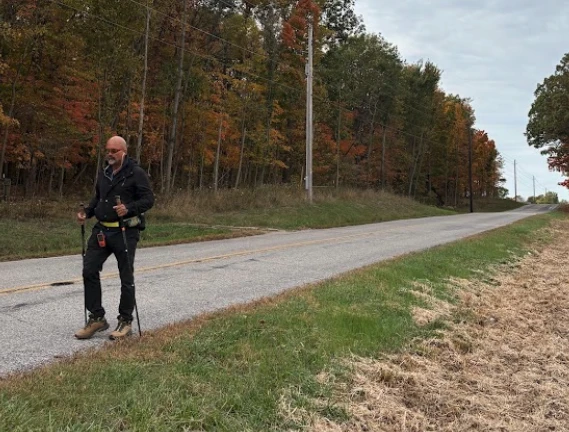

Father Gary Graf walks down a rural road during his trek across America in support of immigrants on Friday, Oct. 17, 2025. / Credit: Photo courtesy of Father Gary Graf
CNA Staff, Nov 24, 2025 / 06:00 am (CNA).
After a month and a half of walking an average of 17 miles a day, 67-year-old Father Gary Graf said he is starting to get “a little pain in one shin,” but his broken ribs are “getting much better.”
On Oct. 6, Graf, a Catholic priest from Chicago, began a journey on foot from Pope Leo XIV’s childhood home in Dolton, Illinois, to New York City to bring attention to the plight of immigrants amid the sometimes “inhumane” ways the Trump administration is treating them during its immigration enforcement actions.
He hopes to arrive at the Statue of Liberty on Ellis Island, where his own great-grandparents entered the country as immigrants, by Dec. 2.

A few weeks ago, when visiting a parish in Indiana, he was invited to ride a horse. He fell off as it galloped and broke several ribs, which led him to take one day off to recover. That day, friends walked in his stead.
Graf, the pastor of the mostly Hispanic Our Lady of the Heights Catholic Church in Chicago Heights and a longtime member of Priests for Justice for Immigrants, has committed his life to helping immigrants. Ordained in 1984, he spent five years as a priest in Mexico serving a people “with whom I fell deeply in love.”
He told CNA that after initially feeling helpless watching the raids taking place against his beloved community in his hometown of Chicago, he “felt a call that was directly from above” to start walking.

Within weeks, he was on the road. He first spoke to an old friend about his idea, who immediately connected him with Lauren Foley, the head of a public relations firm. She “immediately embraced the idea,” and between her help and that of some “young people who understand social media,” a website as well as social media accounts were set up to chronicle his journey and to share the stories of immigrant families.
Of the immigrants on whose behalf he is walking, Graf said: “I look to help people who get up every single morning to work and raise their families. If I can do this small gesture on their behalf, what a blessing it is, what a privilege.”
Asked about the most profound insight he has gained thus far, Graf said his long days walking through the wide expanse of rural America have helped him understand better the ways of people who did not grow up in a multicultural city like he did.
“We have to reverently appreciate and try to connect with those whose lives we’re passing through,” he said.
As he has spoken with people in diners along his path, Graf has developed “a greater sensitivity,” discovering that “there’s not a lot of animosity against the immigrant.”
Many of the people he has met simply do not know any, he said.
Along the way, he has also experienced unity with Christians from other denominations, as well as with those without religious faith, who all care about the humane treatment of human beings.
“I have seen so much goodness,” he said. “This has brought so many of us together: people from many different faith traditions, or none. This is an opportunity given to us.”
During his quiet walks through rural farmland, he has marveled at the amount of labor it took to build the many roads, bridges, and overpasses he has seen.
“I’m sure the hands of many immigrants helped build these things,” he reflected.
Graf said he is delighted that both the U.S. Conference of Catholic Bishops and Pope Leo XIV addressed the immigration enforcement situation in the past week.
The U.S. bishops issued a special message during its Fall Plenary Assembly two weeks ago, calling for “a meaningful reform of our nation’s immigration laws and procedures.” The bishops argued that “human dignity and national security are not in conflict. Both are possible if people of goodwill work together.”
The pope echoed the bishops’ message. On Nov. 18, he acknowledged to reporters that “every country has a right to determine who and how and when people enter.”
“But when people are living good lives, and many of them for 10, 15, 20 years, to treat them in a way that is extremely disrespectful, to say the least — and there’s been some violence, unfortunately — I think that the bishops have been very clear in what they said.”
“I think that I would just invite all people in the United States to listen to them,” the pope said.
“Both the pope and the bishops used the word ‘indiscriminate’ to talk about the way people are being singled out and aggressively having their wrists zip-tied behind their backs as their faces are pushed to the ground in front of their children,” Graf said.
“It is indeed indiscriminate. This reflects dishonesty on the administration’s part,” he said. “They said they were going after the ‘worst of the worst,’ criminals, but this isn’t the case, at least in Chicago. They’re grabbing people first and asking questions later.”
“The violent way many of these people are being treated is amoral and un-American,” he said.
Like the pope and the American bishops, Graf said he hopes the federal government will establish a more humane immigration system that respects the dignity of immigrants as well as the rule of law and the country’s right to regulate its borders.
“I am not a politician,” he said. “My job is to mediate, to speak up, in God’s name, in the united name of the Church. But can we look for a way for those who are fulfilling their responsibilities; for them to one day receive the rights of citizens?”
The priest, who appeared on “EWTN News Nightly” in October, said he has been “impressed by the media” and is grateful his message is being spread.
“If we don’t hear the whole truth, the incredible ignorance and darkness we live in can paralyze us, and keep us from doing what we ought to do,” he said.
Read More



![How pregnancy centers help women: Centers provide $450 million in value, report finds #Catholic
Jessica Williams and her 3-year-old daughter were helped by First Choice Pregnancy Services in Las Vegas. / Credit: Photo courtesy of Susan B. Anthony Pro-Life America
CNA Staff, Nov 17, 2025 / 16:11 pm (CNA).
When Jessica Williams became pregnant with another man’s child while she and her husband were separated, her husband pressured her to abort the child.As soon as she took the first abortion pill, mifepristone, she regretted it. “As a nurse, the reality of what I had done had hit me hard,” said Williams, who was nine weeks pregnant at the time. “Here I was working to save lives and about to take one of my own child’s lives.” But as a nurse, Williams knew that in spite of the pill cutting off the progesterone supply to her child, the baby might still be alive. She hadn’t yet taken the second pill, misoprostol, which would expel the child from her body. When she found a pregnancy center, First Choice Pregnancy Services in Las Vegas, staff immediately brought her in for an ultrasound.“They provided a free ultrasound, and that moment changed everything,” she said. Her baby was still alive.First Choice helped her through the abortion pill reversal process, a practice to reverse the effects of mifepristone soon after the woman takes the first abortion pill. Now, her daughter is a “healthy” and “thriving” 3-year-old, Williams said when she shared her story at a Nov. 17 online press conference.Williams is one of many women who have received help from pregnancy resource centers. Pregnancy centers across the U.S. “provided over $452 million in total medical care, support and education services, and material goods in 2024,” according to a Nov. 17 report by the Charlotte Lozier Institute. Pregnancy centers saw a total of 1 million new patients last year, “which is the equivalent of each center serving a new client every day in 2024,” Karen Czarnecki, the head of Charlotte Lozier Institute, said during the press conference. During the press conference, Marjorie Dannenfelser, head of Susan B. Anthony Pro-Life America, called pregnancy centers the “beating heart” of pro-life movement. Pregnancy centers, Dannenfelser said, “are going to the roots of the problem” by providing support for mothers across the board, whether they are struggling with addiction, domestic abuse, homelessness, completing school, or any other challenge. Report debunks false claims about pregnancy centers Dannenfelser noted there are some claims “often unchecked in the media” that call pregnancy centers “fake clinics” or say they “don’t have licensed medical staff.”“This is flat-out false,” Dannenfelser said. “Eight in 10 centers are providing free or low-cost medical services, staffed by over 10,000 medical professionals.” More than 80% of these centers provide ultrasound services, according to the report. Many of the centers also provide STD and STI testing and treatment, as well as abortion pill reversal, like in Williams’ experience. The report also found a 98% satisfaction rate among their clients — something Williams attested to.“They greeted me gently and were nonjudgmental,” Williams said of the staff and volunteers at the pregnancy clinic she went to. “They provided a safe, calm space for me, emotionally, spiritually.”“They gave me information and education without pushing me in any direction,” she continued. “They simply supported me in whatever path I chose.”More than three years later, Williams still keeps up with the women at the clinic.“I’m meeting with these ladies every month still,” Williams said. “They’re just a phone call, a text away, anything I need. I mean, we’re just almost becoming a family now.” Pregnancy centers also provide material, educational, and emotional support. For instance, 92% of centers offer material items to women in need. On average, each pregnancy center distributed six-packs of diapers and five baby outfits every day, according to the report. First Choice “provided diapers, material support, emotional and spiritual support groups, parenting resources, community connections, and just so much practical help in general,” Williams said. “It was a level of compassion that carried me through my entire pregnancy.” Offering material support is a growing effort in the pro-life movement. At pregnancy centers, material support has grown by more than 300% from 2019 to 2024.Many pregnancy centers also offer a variety of other resources, including childbirth classes, breastfeeding consultations, and outreach to victims of human trafficking. “Even right now, they’re doing a monthly get-together — we get to network with other mamas,” Williams said. “We’re [able] to access any resources.” The majority of pregnancy centers also help support women who are recovering from abortions.Williams said the women at the clinic “understood the pressure and fear” she was under to abort. Even after the reversal, her husband drove her to an abortion clinic when she was 16 weeks pregnant “to finish the job,” she said. “The clinic was on the same exact street [where] I saved my baby,” she said. “I couldn’t do it and demanded he take me home. I now know that the strategic location has also saved many other babies.” “They created a safe place for me to heal and feel supported,” she said of the clinic.](https://unitedyam.com/wp-content/uploads/2025/11/how-pregnancy-centers-help-women-centers-provide-450-million-in-value-report-finds-catholic-jessica-williams-and-her-3-year-old-daughter-were-helped-by-first-choice-pregnancy-services-in-las-v.webp)





![Religious sisters announce historic land return to Wisconsin Native American tribe #Catholic
LaCrosse, Wisconsin. / Credit: JTTucker/Shutterstock
CNA Staff, Nov 7, 2025 / 06:00 am (CNA).
A Wisconsin religious community says it has completed the first known instance of a Catholic group returning land to a Native American tribe, hailing it as a move made in the “spirit of relationship and healing.”The Franciscan Sisters of Perpetual Adoration announced the transfer in an Oct. 31 news release on its website. The community is located in La Crosse, Wisconsin, near the state’s border with Minnesota.The sisters had purchased the land from the Lac du Flambeau Band of the Lake Superior Chippewa tribe in 1966 and used the property for its Marywood Franciscan Spirituality Center.The sisters said they sold the property to the tribe for $30,000, the exact amount for which they paid for the land six decades ago. The modern sale price represented “just over 1% of [the land’s] current market value,” the sisters said.The bargain sale represents “the first known return of Catholic-owned land to a tribal nation as an act of repair for colonization and residential boarding schools,” the sisters said.“Today, the tribe’s reservation represents only a fraction of [its] traditional territories,” the news release said. “Rebuilding and protecting tribal land bases is vital to sustaining sovereignty — it restores the ability for self-determination, cultural preservation, and community development.” “A strong land base supports essential services, creates employment opportunities, and provides a foundation for long-term economic and social resilience,” the sisters said. Tribal President John Johnson hailed the sale as “an example of what true healing and partnership can look like.” “We are proud to welcome Marywood home, to ensure it continues to serve future generations of the Lac du Flambeau people,” Johnson said. The sisters said the retreat center was “facing challenges to its viability,” leading the community to “discern a future for the land” in line with its institutional priorities. In their press release, the sisters said they have also been in “a process of reckoning” with the history of St. Mary’s Catholic Indian Boarding School. The sisters administered the school in Odanah, Wisconsin, from 1883 to 1969.Critics in recent years have claimed that such boarding schools participated in the erasure of Native American culture. Others have alleged that significant clergy sex abuse took place at such institutions.The sisters on Oct. 31 said such schools were guilty of “separating children from their families, suppressing Native identity, and paving the way for the large-scale seizure of Native homelands.”“It was painful to address our complicity, but we knew it had to be done,” former community president Sister Eileen McKenzie said in the press release.Diocese of Superior Bishop James Powers, meanwhile, praised the transfer, describing it as “a tangible act of justice and reconciliation that flows directly from the heart of our Catholic faith.”The Franciscan Sisters of Perpetual Adoration traces its roots to a group of Bavarian immigrants who traveled to Milwaukee in 1849 “intent upon founding a religious community to spread the Gospel among German immigrants.”The community has run hospitals and schools in Wisconsin and has also sponsored medical clinics and mission schools abroad.](https://unitedyam.com/wp-content/uploads/2025/11/religious-sisters-announce-historic-land-return-to-wisconsin-native-american-tribe-catholic-lacrosse-wisconsin-credit-jttucker-shutterstockcna-staff-nov-7-2025-0600-am-cna-a-wiscon.webp)

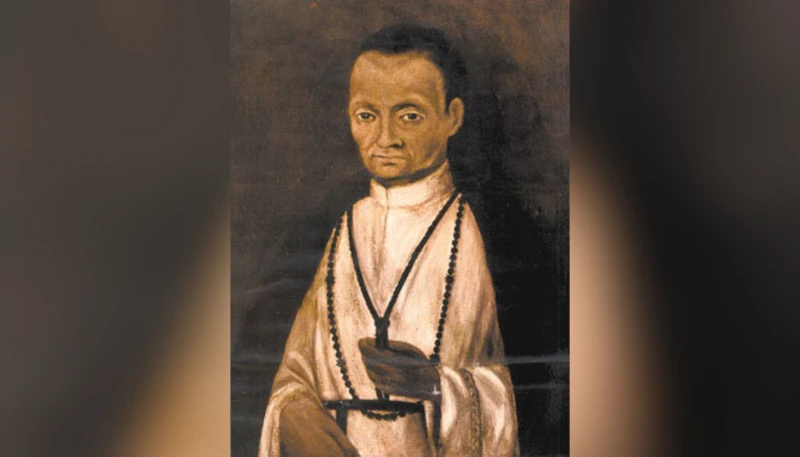

![Preparing for death with the Sister Servants of Mary #Catholic
The Sister Servants of Mary hold a procession with the statue of Our Lady of the Assumption at Mary Health of the Sick Convalescent Hospital in Newbury Park, California. / Credit: Photo courtesy of the Servants of Mary, Ministers to the Sick
CNA Staff, Nov 2, 2025 / 06:00 am (CNA).
When a 93-year-old Catholic father from New Orleans had a stroke, he knew he was prepared to die.Clinton Jacob attended adoration and Mass daily and was “rarely without a prayer book or rosary in hand,” according to his daughter, Kim DeSopo.“[He] never spoke of death with fear or sadness,” she told CNA. “He would simply say, ‘I’ll be going home.’”But not everyone feels prepared for death.The Servants of Mary, Ministers to the Sick, is a Catholic community of sisters who dedicate their lives to caring for the sick and dying in New Orleans and around the world. As nurses, they are at the bedside of the dying through the long nights, whether their patients are lifelong Catholics or have never thought about religion.The sisters often encounter patients as well as family members who are struggling to accept “an illness or imminent death,” Sister Catherine Bussen, a Servant of Mary, told CNA.“Many times, there is a need for reconciliation within the family, for a return to their faith, for acceptance of their condition, etc.,” Bussen said.As medical professionals, the sisters provide physical treatment, but they also walk with their patients throughout their illnesses, encouraging patients and families “always with the hope of eternal life,” Bussen said. DeSopo, Jacob’s daughter, called the sisters for support. The next day, Bussen arrived at their doorstep, and every night for two weeks, she sat at Jacob’s bedside. Bussen’s presence was “a gift,” DeSopo said. “Sister Catherine brought peace and calm into a time filled with stress and sorrow.”“Her prayers, patience, and care provided comfort not only to my father but also to my mother, who could finally sleep knowing someone trustworthy and compassionate was by his side,” DeSopo said, recalling Bussen’s “selfless dedication” and “unwavering faith.” Bussen was with Jacob when he died on Sept. 26, 2024. She prepared his body, cleaning him and sprinkling him with holy water, and then prayed with his wife and daughter.“I will never forget the care and dignity she gave him, even after his final breath,” DeSopo said.Sister Catherine (left) and Sister Dorian Salvador (right) pray for the soul of Kim DeSopa’s father on Oct. 1, 2024, at St. Clement of Rome Church in Metairie, Louisiana. Credit: Photo courtesy of Kim DeSopa and Sister CatherineMary at the foot of the cross “I was sick and you visited me.”This Scripture verse, Matthew 25:36, summarizes the charism of the Servants of Mary, according to Bussen. When they care for the sick, they care for Christ.The sisters will care for anyone in need, preferably within the sick person’s own home. In those who are suffering, the sisters “discover Jesus carrying his cross,” Bussen explained. “By caring for the sick, we believe that we are caring for Christ himself, who still suffers today in the suffering mystical body of Christ,” she said.Sister Angélica Ramos cares for Mrs. Hura, a resident of Mary Health of the Sick Convalescent Hospital in Newbury Park, California. Credit: Photo courtesy of the Servants of Mary, Ministers to the SickFounded in Madrid, Spain, in the 1800s, the sisters care for the sick and dying in Louisiana, Kansas, and California as well as throughout Central and South America, Spain, France, England, Italy, Cameroon, the Philippines, and Indonesia. They run a hospital for the poor in Bamenda, Cameroon, as well as two missionary houses in Oaxaca, Mexico.The sisters look to Mary as an example as they accompany those who are suffering.“Although we are not able to take away someone’s cross, we are present to them, offering all to the Father, like Mary did at the cross of Jesus, that all suffering may be redemptive and fruitful,” Bussen said.“Every one of us sisters would tell you that it is an absolute privilege to be able to enter into the intimacy of a family’s home, listening to the dying, praying with them, and encouraging them on the final stage of their journey as their soul passes into eternity,” she said.Sister Servants of Mary Fatima Muñoz and Carmela Sanz (front) celebrate a May crowning in Kansas City, Kansas. Credit: Photo courtesy of the Servants of Mary, Ministers to the Sick“Our Catholic Christian faith is a beautiful comfort during these times because it is all about looking forward to the promised life to come, the whole goal of our lives, eternal life,” Bussen said.One woman from New Orleans received news no one wants to hear — she had a terminal illness. Though she was not religious, she knew she needed help and did not know who else to turn to, so she called the Servants of Mary.As they cared for her and helped her deal with her terminal diagnosis, the sisters learned the woman was “completely alone in the world,” said Bussen, who took care of her. Other people from the surrounding Catholic community volunteered to stay with her.During that time, the woman found a home in the Catholic Church and received the sacrament of baptism.Her “anxiety was transformed into peace,” said Bussen, who was with her as she died.“As the end drew near, she had a new faith family,” Bussen said. “She was no longer alone.”Remembering the dead The life of a sister Servant of Mary is “contemplative in action.” The sisters unite “our prayer life with our work — going about what we are doing, in all the business of daily life, in a prayerful spirit,” Bussen said.The sisters have time set aside for prayer and work, “but these two aspects cannot be separated from one another,” she continued. “The grace and light received in prayer flows into our work and ministry, and everything we experience in our ministry is taken to prayer.”The Servants of Mary, Ministers to the Sick care for the sick and the dying. Credit: Photo courtesy of the Servants of Mary, Ministers to the SickThroughout the year, the sisters take special care to remember the dead. In November especially, Bussen said the sisters “remember all our patients who have died with us by placing their names in our chapel and offering Masses for their eternal happiness.”“Even after a patient has passed,” she said, “and they no longer need physical care, our ministry continues by praying for their soul.”](https://unitedyam.com/wp-content/uploads/2025/11/preparing-for-death-with-the-sister-servants-of-mary-catholic-the-sister-servants-of-mary-hold-a-procession-with-the-statue-of-our-lady-of-the-assumption-at-mary-health-of-the-sick-convalescent-h.webp)












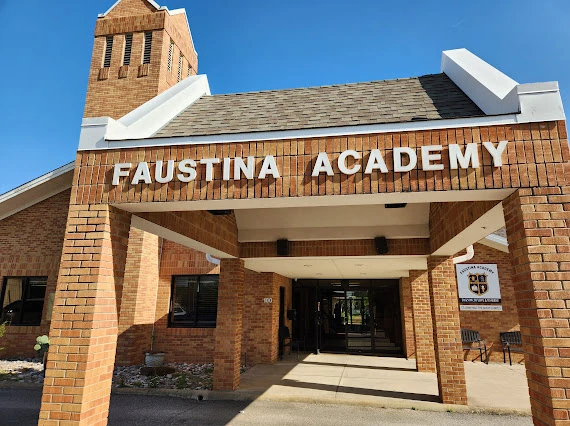




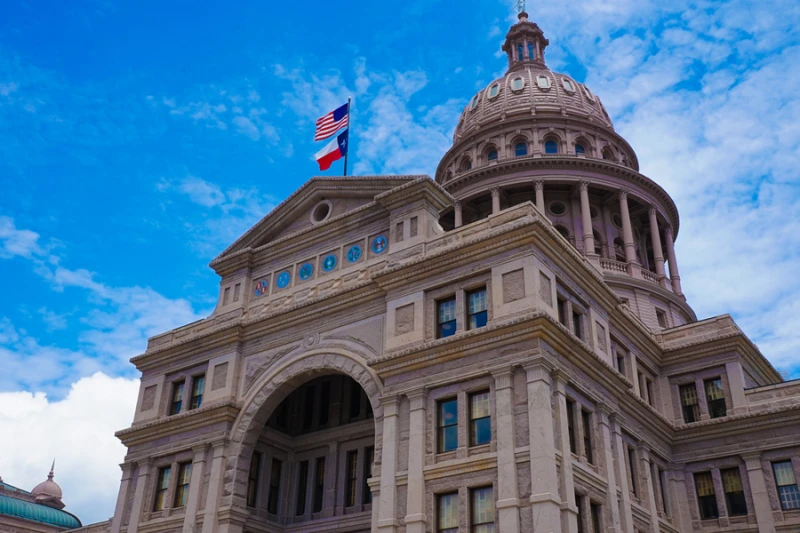

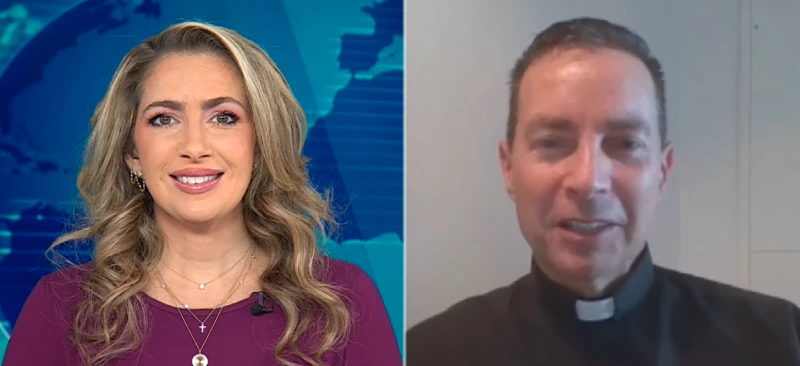

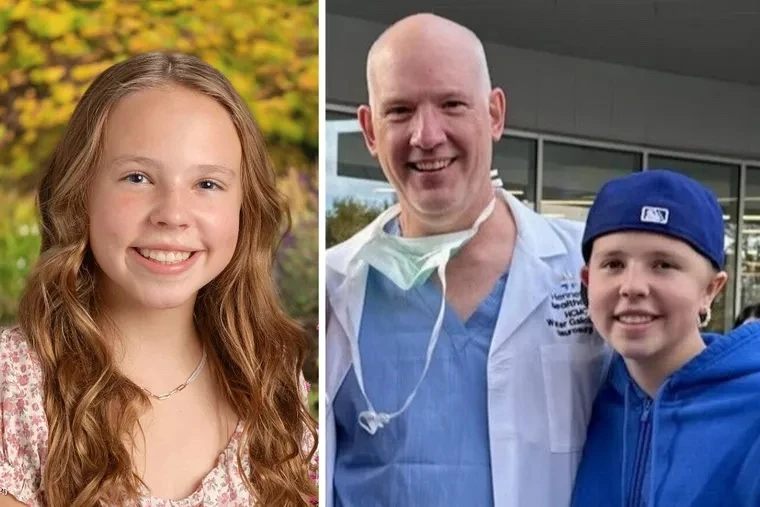



![Bill proposed in Hungary could require priests to violate seal of confession #Catholic
null / Credit: AS photo studio/Shutterstock
Washington, D.C. Newsroom, Oct 24, 2025 / 06:00 am (CNA).
Here is a roundup of Catholic world news from the past week that you might have missed:Bill proposed in Hungary could require priests to violate seal of confessionThe Permanent Council of the Hungarian Catholic Bishops’ Conference has expressed shock over the proposition of a bill that would require Catholic priests to violate the seal of confession. “This is in serious conflict with the agreement between the Republic of Hungary and the Holy See of Feb. 9, 1990, which states that the Catholic Church in our county operates on the basis of [canon law],” the council stated in an Oct. 17 press release. The council expressed regret over “extremely crude” and “baseless sentiment-mongering and slander” that has occurred during the ongoing election cycle. “We emphasize to our priests, all believers, and society that we are not a political organization, we do not wish to participate in the campaign,” it stated. “Our mission is to serve the salvation of souls.” Church in South Korea pledges help for Timorese migrants The Catholic Church in South Korea has pledged to help improve the situation for migrants from the small Catholic-majority island country of Timor-Leste.During an Oct. 11–15 visit to the island, a 12-member delegation of South Korean Catholics from the Committee for Pastoral Care for Migrants of the Catholic Bishops’ Conference of Korea visited with groups that send migrant workers to South Korea, Cardinal Virgílio do Carmo da Silva, as well as President José Ramos-Horta and Prime Minister Xanana Gusmão, according to UCA News. The delegation pledged to help bring about “better protection and welfare of migrant communities” and to “improve better pastoral care program[s] for Timor-Leste migrants,” of which there are approximately 7,000 living in South Korea.Australian archbishop renews commitment to safeguarding childrenArchbishop Tony Ireland of Hobart in Tasmania, Australia, has reaffirmed his commitment to ensuring all Catholic communities and workplaces throughout his diocese uphold safe environment standards. “The safety and well-being of all who engage with the Church is foremost in my mind and heart,” the archbishop said in an Oct. 17 statement. “Ensuring that every person — regardless of age or circumstance — feels safe, valued, and respected is an essential part of our mission and witness.” On behalf of his archdiocese, Ireland endorsed the National Catholic Safeguarding Standards, stating: “Our commitment to these standards is unwavering, reflecting zero tolerance of any form of abuse, neglect, or exploitation.” The archdiocese has remained engaged in its safeguarding measures since 2017. Madagascar cardinal urges international community to refrain from sanctioning country Cardinal Désiré Tsarahazana of Toamasina, Madagascar, is appealing to the international community not to sanction Madagascar in wake of a coup staged by military-backed youth protesters. The cardinal told Vatican media that imposing sanctions “would be illogical and immoral.”“Supporting young people who demand a better life and then killing them with sanctions would make no sense,” Vatican News Italy reported. Religious conversion case against Christian university officials in India droppedThe Supreme Court of India has dropped a criminal case against three Christian university officials in Uttar Pradesh who were accused of violating the state’s stringent anti-conversion laws. The court dropped the case on Oct. 17, citing “legal defect” in the allegations filed by Himanshu Dixit, vice president of the World Hindu Council, according to UCA News. The Hindu leader had accused officials from the Presbyterian Sam Higginbottom University of Agriculture, Technology, and Sciences of “unlawful conversion activities” in addition to “cheating, criminal intimidation, and forgery,” according to the report.The judges noted that under Uttar Pradesh law, only an “aggrieved” person — that is, a victim or close relative — of the violation is permitted to lodge a complaint. The court declined to dismiss charges related to cheating and forgery but ordered protection of the accused from arrest.Church in Mozambique proposes political guide for dialogueThe Episcopol Justice and Peace Commission in Mozambique has proposed a document outlining “concrete proposals for reforms of the state, the electoral system, natural resource policies, economic inclusion, and national reconciliation.”The document, “A Political Guide for National Dialogue,” proposes limited power for the president in appointing heads of state, that judges be elected among their peers, and that the position of secretary of state be eliminated in provinces for the sake of the country’s budget, according to an Oct. 20 report from Vatican News. The guide also recommends the elimination of electronic voting to combat fraud as well as economic and natural resource reforms. To address the county’s unrest, the document proposes “building a collective memory based on truth, exercising forgiveness and mutual listening, promoting a culture of dialogue and trust, and changing mentalities to value differences while combatting prejudices.”Latin American bishops host ‘virtual jubilee’ for Indigenous people The Episcopal Conference of Latin America hosted a virtual jubilee event for Indigenous people of Latin America and the Caribbean on Oct. 14–16. Organized by the Advisory Team on Indian Theology, together with the Pastoral Care of Indigenous People of the Latin American and Caribbean Episcopal Council and the Latin American Ecumenical Articulation of Indigenous Pastoral Care, the event centered on sharing experiences “as pilgrims of hope together with our Indigenous people, authentic custodians of culture, and our common home,” according to a message from Cardinal Michael Czerny, SJ, prefect of the dicastery for promoting integral human development.“Your love for the earth, your respect for the elderly, your sense of community, and your ability to live in harmony with creation are a gift to the whole Church. You teach that life is best understood when lived simply, in relationship with God, with nature, and with others,” he said.](https://unitedyam.com/wp-content/uploads/2025/10/bill-proposed-in-hungary-could-require-priests-to-violate-seal-of-confession-catholic-null-credit-as-photo-studio-shutterstockwashington-d-c-newsroom-oct-24-2025-0600-am-cna-here-i.webp)

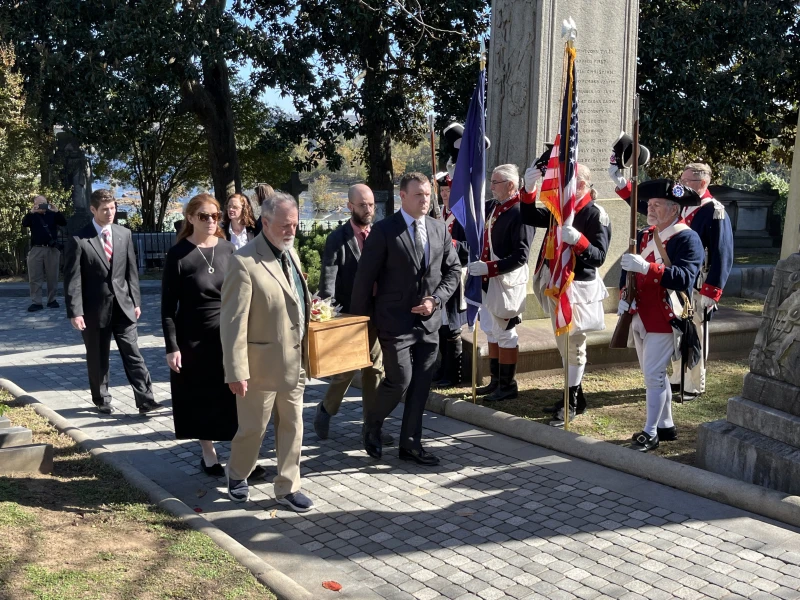







![Missouri court says man can sue St. Louis Archdiocese over abuse he repressed for decades #Catholic
The Cathedral Basilica of St. Louis. / Credit: legacy1995/Shutterstock
CNA Staff, Oct 16, 2025 / 11:48 am (CNA).
A Missouri appeals court has ordered that an alleged victim of clergy sexual abuse can sue the Archdiocese of St. Louis, ruling that an arcane aspect of bankruptcy law does not negate the archdiocese’s potential liability for abuse that the plaintiff allegedly repressed for decades.The case touches on both the complex character of U.S. bankruptcy statutes as well as the often-protracted nature of abuse allegations, which frequently only come to light years or decades after the abuse is alleged to have occurred. In its Oct. 14 ruling, the Missouri Court of Appeals, Eastern District, said the alleged victim, John Doe, claims to have been abused at the St. Joseph’s Home for Boys in the late 1980s. Doe alleges that Father Alexander Anderson, who was assigned as a counselor to the home, sexually abused him; the plaintiff said he “reported the abuse [but] no action was taken,” according to the court. Doe “alleged he repressed his memory of the abuse until 2016,” the court said. He ultimately filed suit against the archdiocese in August 2022. The archdiocese argued in response that Doe’s abuse claim was effectively negated by two bankruptcy claims he had filed in 2008 and 2009. U.S. law dictates that when debtors file for bankruptcy, they create “an estate that includes nearly all of the debtor’s legal or equitable interests in property,” including legal causes of action. The archdiocese claimed that since Doe did not list his abuse claims as “exempted assets” in his bankruptcy proceedings, they became part of that “estate” and can only be administered by the trustee that handled those proceedings. The appeals court rejected the archdiocese’s argument, reversing a lower court decision and holding that Doe’s “cause of action” only arose when he said he remembered the alleged abuse in 2016, “well after” his bankruptcy filings. Doe’s standing to sue “did not accrue [when] the sexual abuse was allegedly committed” but rather when it was “capable of ascertainment,” the court held. The court’s ruling cited Missouri Supreme Court precedent, which holds that, in some cases of abuse, “the victim may be so young, mentally incompetent, or otherwise innocent and lacking in understanding that the person could not reasonably have understood that substantial harm could have resulted from the wrong.”The St. Louis Archdiocese did not immediately respond to a request for comment on the ruling on Oct. 16. This is not the first instance in which the archdiocese has been held accountable for abuse allegations that an alleged victim claimed to have repressed for decades.In 2023 the archdiocese agreed to pay a $1 million settlement to a man who said he was abused by Father Gary Wolken in the mid-1990s but repressed the memories until he was an adult. Wolken was in prison from 2003 to 2015 for sexually abusing another boy in the St. Louis area from 1997 to 2000.](https://unitedyam.com/wp-content/uploads/2025/10/missouri-court-says-man-can-sue-st-louis-archdiocese-over-abuse-he-repressed-for-decades-catholic-the-cathedral-basilica-of-st-louis-credit-legacy1995-shutterstockcna-staff-oct-16-2025.webp)






![Brooklyn usher murdered in subway remembered as ‘tremendous man of faith’ #Catholic
Nicola Tanzi. / Credit: Photo courtesy of Deacon Anthony Mammoliti
CNA Staff, Oct 10, 2025 / 15:37 pm (CNA).
A Catholic man who served as an usher at his Brooklyn parish before he was killed in a brutal attack in a city subway is being remembered as a “good soul” with a “tremendous” faith in Christ.Sixty-four-year-old Nicola Tanzi was killed on Oct. 7, when police say 25-year-old David Mazariegos beat him to death in the Jay Street-MetroTech station in Brooklyn. He later died at New York-Presbyterian Brooklyn Methodist Hospital. New York City Police Commissioner Jessica Tisch described the attack as “horrific.” Police were able to apprehend the suspect using photos and a physical description transmitted through their phones, Tisch said. Mazariegos has reportedly been arrested multiple times before. U.S. Transportation Secretary Sean Duffy said on X that state Gov. Kathy Hochul “has blood on her hands” over the death.“Nicola Tanzi’s life was taken by another repeat offender roaming New York’s streets freely,” Duffy wrote. ”New York needs leaders who will back the blue and make America’s transit system safe again.”Victim mourned as a ‘simple, good person’Those who knew Tanzi have mourned his death in the days following his murder. Deacon Anthony Mammoliti told CNA in an interview on Oct. 10 that Tanzi was “probably the most Christ-like parishioner I’ve encountered.” Mammoliti serves at St. Dominic’s Parish in Bensonhurst where Tanzi attended. Tanzi served as an usher there at the Italian Mass for at least 10 years, the deacon said. “He was a man who would give of himself,” Mammoliti said. “In his civilian job, he would often, without hesitation, switch shifts to allow married colleagues to have family time. When I engaged with him in the parish, it was always with a congenial smile.”Tanzi would regularly greet elderly parishioners with a “Buon Giorni!” and “Come Stai!” while holding the door for them, Mammoliti said. The deacon said the parish is in shock over the news. “We’re all in a state of disbelief. The old expression, ‘Bad things happen to good people,’ that’s the first thought that came to mind,” he said. Deacon John Heyer of Sacred Hearts and St. Stephen Catholic Church in the city’s Carroll Gardens neighborhood told CBS News that Tanzi was “definitely a good person. Like, a simple, good person.”“[He was the] type of guy who went to work and came home and was part of different community organizations,” Heyer said. “Especially those related to his family’s heritage and roots in Mola di Bari, Italy.”Mazariegos, the suspect in the killing, reportedly has multiple criminal cases open against him throughout the city. He allegedly admitted to the killing afterward. Mammoliti said Tanzi, a “tremendous man of faith” with a “good soul,” had he survived the assault, would have forgiven his assailant. “He would have done what he normally did, which was to be a good Christian,” he said.“Your first initial reaction [upon hearing the news] is, you know, eye for eye, tooth for tooth,” the deacon admitted. “But we’re called to be people of faith. We’re called to emulate the teachings of the Gospel.” “We would honor Mr. Tanzi if we would live up to what Jesus teaches us, which is to forgive our enemies.”](https://unitedyam.com/wp-content/uploads/2025/10/brooklyn-usher-murdered-in-subway-remembered-as-tremendous-man-of-faith-catholic-nicola-tanzi-credit-photo-courtesy-of-deacon-anthony-mammoliticna-staff-oct-10-2025-15.webp)












